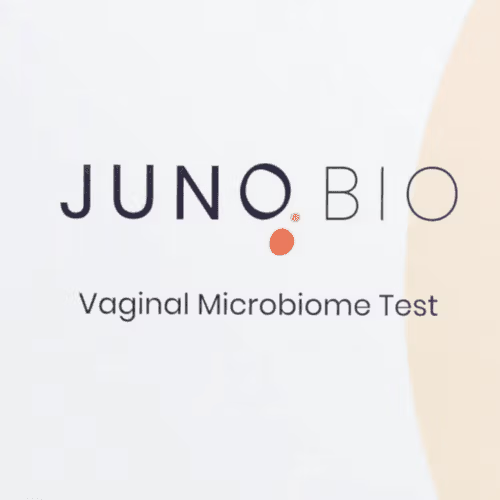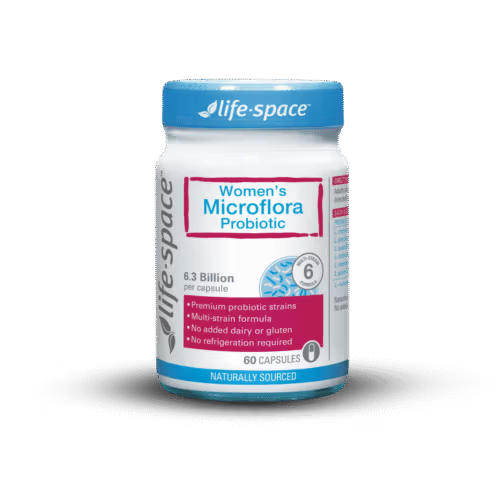Yeasts can go from being a normal part of your flora to an uncomfortable vaginal overgrowth known as a yeast infection (or thrush, depending on where you live).1
Yeast overgrowth is very common, particularly after antibiotics, when your healthy flora may be having a rough time keeping colonies in check.
Symptoms of a yeast infection
- Vulvovaginal itching
- Burning
- Stinging
- Rawness
- Redness
- Discharge – thick, white, sometimes cottage cheese-like
- Yeast infections usually do not smell bad, but may smell yeasty, like bread
- Yeast infections often occur after taking antibiotics
Cyclic vulvovaginitis
You may find that symptoms appear at about the same time in your cycle, repeatedly. This pattern indicates hormones are playing a role.
Often, symptoms will appear when oestrogen levels are higher since oestrogen increases your vaginal glycogen levels. Glycogen is a sugar, which may also feed yeast.
Cyclic vulvovaginitis is the name given to any vaginal or vulvar symptoms (inflammation, itching, infection) that occurs in a pattern related to the menstrual cycle.2
Understanding the gut-vagina link
If you have a vaginal yeast infection, your digestive tract may also have an overgrowth of yeast.3 This matters when it comes to treatment.
Intestinal yeast blooms can be silent, with the only sign being uncomfortable, sometimes painful, vulvovaginal symptoms, but you can also get digestive symptoms such as bloating, gas, constipation, and diarrhoea, and so on.
You may notice that if you eat a lot of carbs or sugar (bread, pizza, burgers, beer or sweets) your vaginal symptoms get worse. A big night out or a lazy weekend in can go bad, and quickly – you’ll notice that the correlation between food or drinks and your vaginal symptoms becomes apparent reasonably fast, sometimes within hours or overnight.
Why do some people call a yeast infection ‘thrush’? The UK, Australia and New Zealand all call a yeast infection ‘thrush’, while North Americans will call it a ‘yeast infection’. They both mean the same thing.
Treating a yeast infection/thrush
There are two ways to approach yeast. The first is the top-down approach, while the second is the bottom-up approach. Or, you can do both.
The top-down approach uses your diet and perhaps a few choice supplements to manage the yeast bloom.4
The bottom-up approach treats only your vagina and vulva. If you do both, you will be covering all bases. Doing both is smart if you have chronic yeast problems and notice a connection between what you eat and drink and symptoms.
If your yeast infection or thrush is a rare event, you may be able to quickly resolve a yeast bloom with some targeted vaginal treatments.5
Effective vaginal yeast infection/thrush treatments
- Aunt Vadge’s Yeast/Thrush Herbal Pessary Blend (suppository) (RECOMMENDED)
- Very effective combined with the Kolorex oral herbal treatment, fighting yeast from the inside out (RECOMMENDED)
- Yeast-specific vaginal biofilm treatment (we like InterFase Plus)
- Kolorex wash or cream to calm irritated skin and fight yeasts (external use only)
- Antifungal treatment from the pharmacy or your doctor (get a test first)6
Getting tested for vaginal yeast species
- Comprehensive vaginal microbiome test to see what’s happening in your vaginal microbiome
- If you have recurrent vaginal thrush or yeast infections (vulvovaginal candidiasis), a comprehensive microbial DNA test is recommended
Other vaginal yeast infection treatment options
- Probiotics orally (Saccharomyces boulardii in particular or a specific vaginal probiotic blend like the Life-Space Women’s Microflora probiotic)
- Diluted apple cider vinegar vaginal rinse (1/4 cup vinegar to 3/4 cup warm water)
- Strong green tea rinse (strong cup of lukewarm green tea)
- Insert live yoghurt vaginally (it has to be alive! Read more)
- Potassium sorbate vaginally
- Povidone-iodine vaginally
- Tea tree and coconut oil pessaries/suppositories
Digestive tract yeast treatment overview
- Cut out or heavily limit carbs for a few days to a few weeks
- Eat live yoghurt (it has to be alive! Read more)
- Probiotics orally (Saccharomyces boulardii in particular)
- Oral antifungal treatment from the pharmacy or your doctor (only after a species/strain test – can cause drug resistance if overused)
- Biofilm-busting enzymes – Aunt Vadge’s Biofilm Enzyme Blend, N-acetylcysteine (NAC), Aunt Vadge’s Nattokinase, InterFase Plus
- Use yeast-fighting herbal Kolorex capsules orally
Yeast biofilms
Yeasts make biofilms, like most microbes. A biofilm is a protective matrix that effectively hides the colony from treatments and helps it take over/protect its patch.
If for some reason the healthy biofilms in your vagina or intestines are disrupted, yeasts can move in and take over more than their allotted share of space.
Too many yeasts and a solid yeasty biofilm mean more infections and frequent recurrences at the slightest provocation.7
Learn more about rare yeasts – Cryptococcal infections.
When yeast grows legs
Some yeast infections can become invasive, working themselves deeply into vaginal tissue. In these cases, often a test result for yeast will come back negative, but symptoms all point to yeast.
Talk to your healthcare provider about invasive yeast if you suspect you have a deeper problem.
More information on treating yeast infections
Test before treating – always
You should be sure it is a yeast infection or thrush by getting a test from your doctor.8 Each strain of yeast is a little bit different, with previously minor, harmless strains, now becoming drug-resistant emerging pathogens.
Comprehensive vaginal microbiome testing is available.
Antifungals can be just as bad as antibiotics when it comes to drug resistance. Using non-resistance-forming treatments (often non-drug treatments) is preferable. If you aren’t sure if you have yeast or something else, do our yeast and BV symptom checker to point you in the right direction.9,10
If you’ve tried lots of yeast treatments and nothing works, look into cytolytic vaginosis – it looks just like a yeast infection, but yeast treatments won’t work.
Types of yeast
There are several types of yeast, with the most common cause of yeast infections and thrush being Candida albicans.11
Candida albicans tends to result in the cottage-cheesy discharge – it can be copious and chunky, though it doesn’t smell bad. (If your discharge smells bad, you may have bacterial vaginosis or another bacterial infection. See your doctor for a test.)
An up and coming pathogen is Candida glabrata. Less common yeasts that can cause vulvovaginal symptoms include Candida tropicalis, Candida parapsilosis, and Candida krusei.
There are some even less common yeasts that can cause yeast infections and thrush, including Saccharomyces cerevisiae, despite some strains being commonly used as a probiotic.
References
- 1.Sun Z, Ge X, Qiu B, et al. Vulvovaginal candidiasis and vaginal microflora interaction: Microflora changes and probiotic therapy. Front Cell Infect Microbiol. Published online February 3, 2023. doi:10.3389/fcimb.2023.1123026
- 2.Yang S, Zhang Y, Liu Y, Wang J, Chen S, Li S. Clinical Significance and Characteristic Clinical Differences of Cytolytic Vaginosis in Recurrent Vulvovaginitis. Gynecol Obstet Invest. Published online June 15, 2016:137-143. doi:10.1159/000446945
- 3.Gouba N, Drancourt M. Digestive tract mycobiota: A source of infection. Médecine et Maladies Infectieuses. Published online January 2015:9-16. doi:10.1016/j.medmal.2015.01.007
- 4.Pendharkar S, Brandsborg E, Hammarström L, Marcotte H, Larsson PG. Vaginal colonisation by probiotic lactobacilli and clinical outcome in women conventionally treated for bacterial vaginosis and yeast infection. BMC Infect Dis. Published online July 3, 2015. doi:10.1186/s12879-015-0971-3
- 5.Chatzivasileiou P, Vyzantiadis T. Vaginal yeast colonisation: From a potential harmless condition to clinical implications and management approaches—A literature review. Mycoses. Published online May 23, 2019:638-650. doi:10.1111/myc.12920
- 6.Zhang L, De Salvo R, Ehret A, Young K, Trapp S. Vulvovaginal candidiasis: A real-world evidence study of the perceived benefits of Canesten®. SAGE Open Medicine. Published online January 2022:205031212210854. doi:10.1177/20503121221085437
- 7.Davies S, Johnson E, White D. How to treat persistent vaginal yeast infection due to species other thanCandida albicans. Sex Transm Infect. Published online November 24, 2012:165-166. doi:10.1136/sextrans-2012-050669
- 8.Nyirjesy P, Brookhart C, Lazenby G, Schwebke J, Sobel JD. Vulvovaginal Candidiasis: A Review of the Evidence for the 2021 Centers for Disease Control and Prevention of Sexually Transmitted Infections Treatment Guidelines. Clinical Infectious Diseases. Published online April 13, 2022:S162-S168. doi:10.1093/cid/ciab1057
- 9.Dermendzhiev T, Pehlivanov B, Petrova A, Stanev S, Murdjeva M. Quantitative system for diagnosis of vulvovaginal candidiasis. Journal of Medical Mycology. Published online November 2022:101302. doi:10.1016/j.mycmed.2022.101302
- 10.Donders G, Bellen G, Ausma J, et al. The effect of antifungal treatment on the vaginal flora of women with vulvo-vaginal yeast infection with or without bacterial vaginosis. Eur J Clin Microbiol Infect Dis. Published online September 28, 2010:59-63. doi:10.1007/s10096-010-1052-6
- 11.Mishra VH. Vaginal Yeast Infections: Causes, Symptoms, Diagnosis, and Treatment. Journal of Preventive, Diagnostic and Treatment Strategies in Medicine. Published online October 2024:303-304. doi:10.4103/jpdtsm.jpdtsm_80_24







